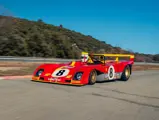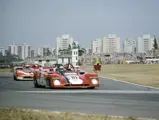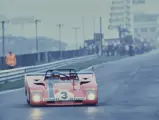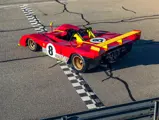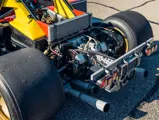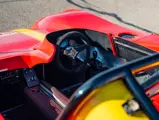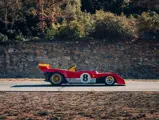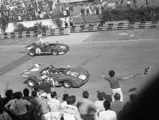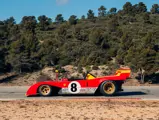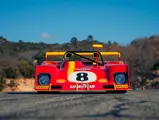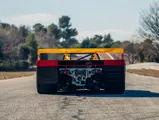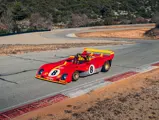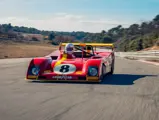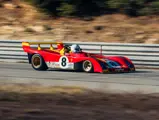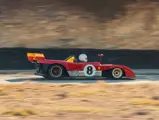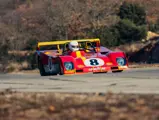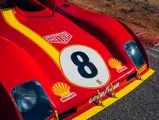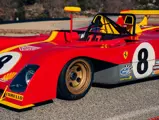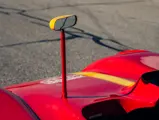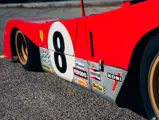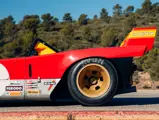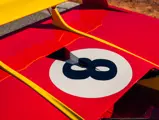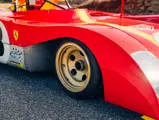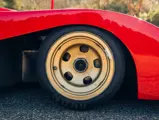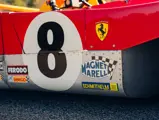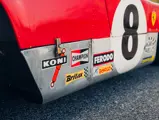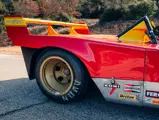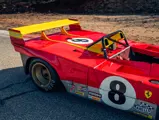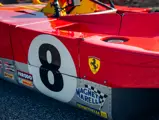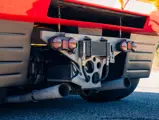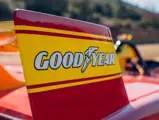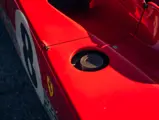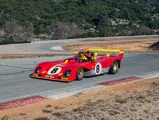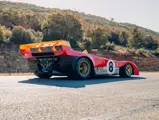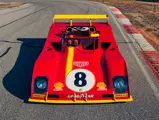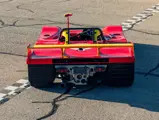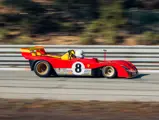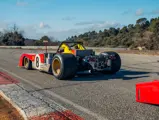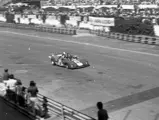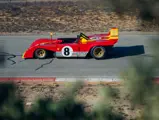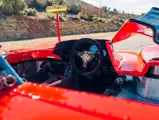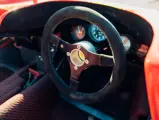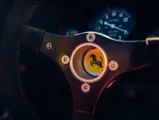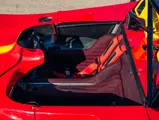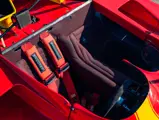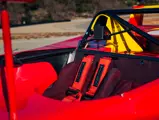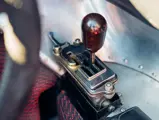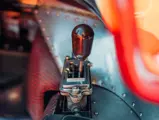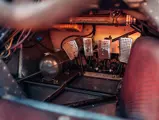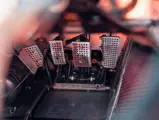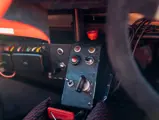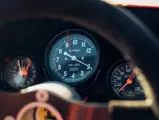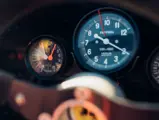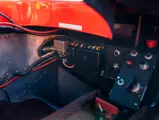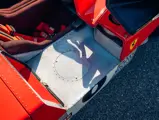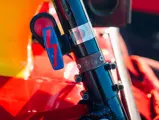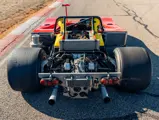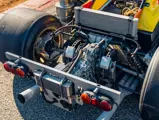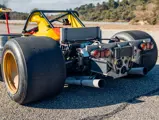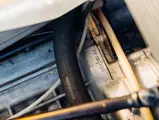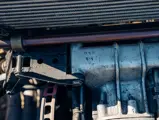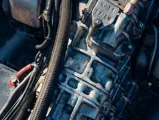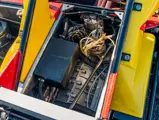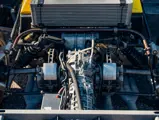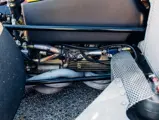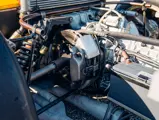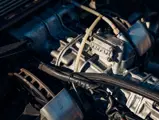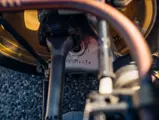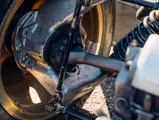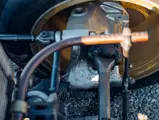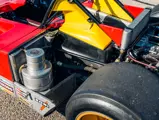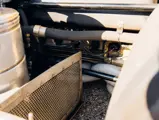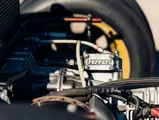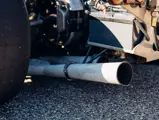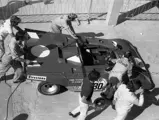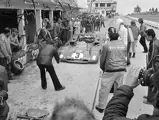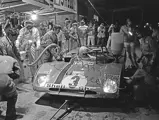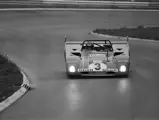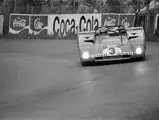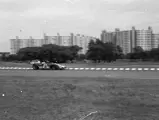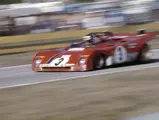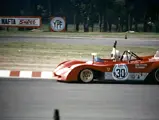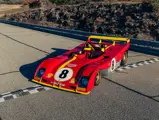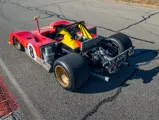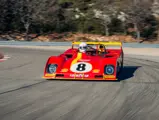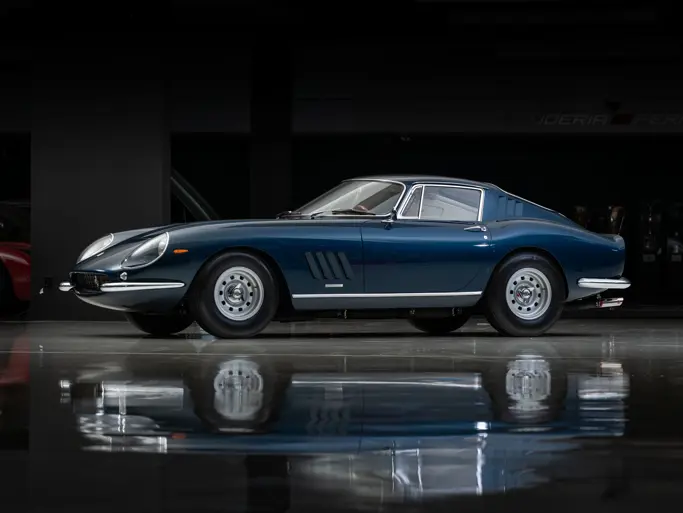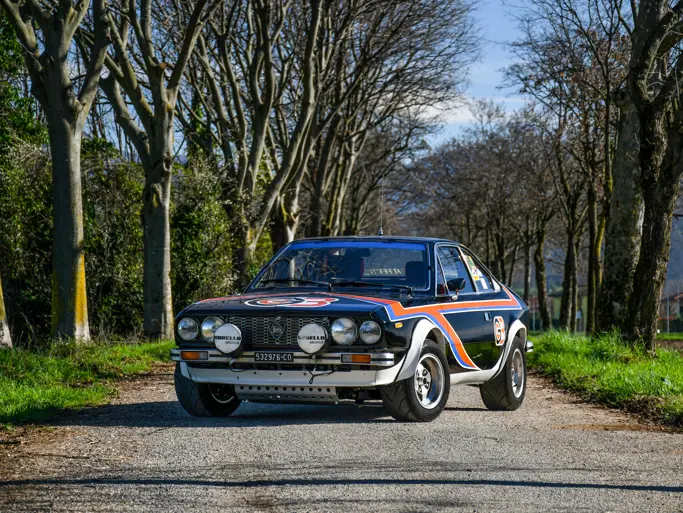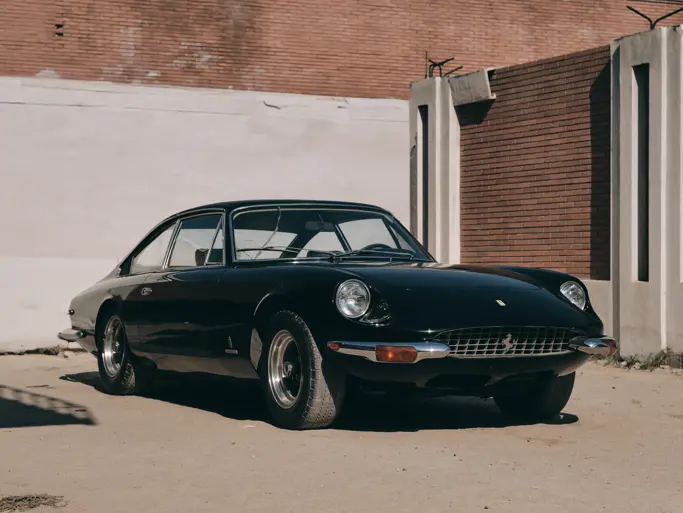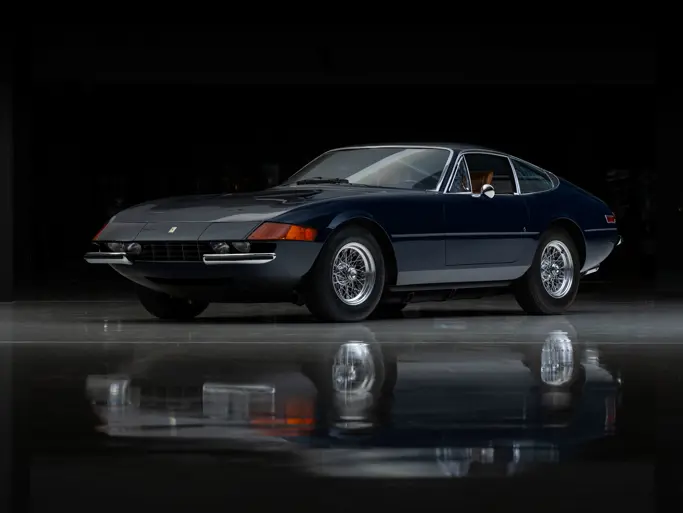Villa Erba 2023
1972 Ferrari 312 PB
{{lr.item.text}}
€12,042,500 EUR | Sold
 | Cernobbio, Italy
| Cernobbio, Italy
{{internetCurrentBid}}
{{internetTimeLeft}}

- Winner of the 1972 Buenos Aires 1,000 Kilometres and the 1972 Nürburgring 1,000 Kilometres
- 2nd-place finish at the 1972 12 Hours of Sebring, and 3rd-place finish at the 1972 Monza 1,000 Kilometres
- Scuderia Ferrari Works example campaigned by the factory to a landslide win in the 1972 World Sportscar Championship of Makes
- The final evolution of Ferrari’s celebrated prototype-class “P” cars
- The last Ferrari Works sports prototype to compete and win the World Sportscar Championship
- One of the most original Ferrari 312 PB extant, retaining its factory matching-numbers engine and gearbox
- Engineered with Formula 1-derived technologies, including the rare 3-litre flat-12 engine
- Accompanied by numerous spare parts, including spare engine and bodywork
- Vincitrice nel 1972 della 1000 Chilometri di Buenos Aires e del Nürburgring
- Sempre nel 1972, seconda alla 12 Ore di Sebring e terza alla 1000 Chilometri di Monza
- Fece parte della Scuderia Ferrari che nel 1972 dominò e portò a Maranello il titolo del Campionato Marche Sport Prototipi
- Evoluzione finale della tanto osannata classe “P” sport prototipi
- Ultimo prototipo sportivo Ferrari a correre e vincere il Campionato Mondiale Sport Prototipi
- Una delle Ferrari 312 PB più originali esistente, che mantiene l’abbinamento dei numeri di fabbrica relativi a motore e cambio
- Progettata con tecnologie derivate dalla Formula 1, compreso il raro motore Boxer 12 cilindri da 3 litri
- Corredata di numerosi pezzi di ricambio, compreso motore, cambio e carrozzeria
The Ferrari “P” series of sports racing prototypes stretched approximately a decade from 1963 to 1973 and resulted in some of the most iconic and legendary achievements in Ferrari’s illustrious racing history. Included among these were back-to-back victories at the 24 Hours of Le Mans in 1963 and 1964 and the famous 1-2-3 finish at the 1967 24 Hours of Daytona, which led to its triumph over Ford in the World Championship that year.
Fiat’s acquisition of Ferrari in 1969 lent a jolt of newfound financial support to the racing program, and throughout 1971 the 312 P sports prototype was further refined. In its typical fashion of exploring various engine combinations, Maranello had modified the flat-12 motor from the 1971 312 B grand prix car for use in the sports prototype racecar.
Christened as the 312 PB, the new prototype made its debut at Brands Hatch in mid-1971. Fitted with a dry-sump lubrication system, Lucas fuel injection, single-plug ignition, and dual-overhead cam actuation for each cylinder bank, the 312 PB’s 3-litre flat-12 developed 460 horsepower at 10,800 rpm, which was the preferred tuning for the 1,000-kilometre races. Weighing less than 650 kilograms, the 312 PB featured a semi-monocoque chassis, cooling radiators on both sides just aft of the cockpit, and a 120-litre fuel tank that was mounted opposite the driver’s position for optimal weight balance. As development continued throughout 1971, the stage was set for a promising campaign in 1972. Little did anyone suspect that it would prove to be one of Ferrari’s most successful sportscar racing seasons of all time.
The featured lot, chassis 0886, was assigned as one of the principal six Scuderia Ferrari Works cars to run the 1972 Group 6 sports prototype racing season. In its debut at the Buenos Aires 1,000 Kilometres in January 1972, Works drivers Ronnie Peterson and Tim Schenken drove 0886 to its first of three pole positions that season. Wearing race number 30, the car leapt out to the lead following a flying start. While the other two PBs experienced their share of mechanical challenges during the race, chassis 0886 steadily advanced, eventually roaring to victory.
Following the race in Buenos Aires, the three spiders were returned to the factory for further preparation while chassis numbers 0888, 0890, and 0892 were dispatched for the season’s second race at Daytona. The first three cars returned in March for the 12 Hours of Sebring. Equipped with a new quick-change gearbox and thicker brake pads with revised calipers, chassis 0886 wore race number 3 and was again driven by Peterson and Schenken. By lap 80, it became apparent that the three Ferraris would likely sweep the podium, however, the fuel pump of chassis 0886 soon developed issues, and before long he ran out of fuel entirely, forcing him to run to the pit to retrieve more. By nightfall Peterson had regained 3rd place and was able to further move up to 2nd by the finish, only two laps behind the winning car of Jacky Ickx.
Chassis 0886 returned to action at the Monza 1,000 Kilometres in April. Now using race number 2, its coachwork was modified with a new rear cowling with trailing fins and secondary NACA ducts, the result of experiments conducted at the Le Mans practice sessions. The race was plagued by unrelenting rain and, although Peterson secured pole position, he came home behind teammates Ickx and Clay Regazzoni, further to a Porsche runner-up, to finish 3rd with Schenken.
The final outing for chassis 0886 took place at the Nürburgring 1,000 Kilometres in May wearing race number 3, where Peterson and Schenken again earned pole position. Despite another rain-swept start, Peterson drove furiously, establishing one lap record after another before giving way to Schenken on the 25th lap. The lead was so commanding that chassis 0886 was never further challenged in the race and roared to a resounding victory. This win resulted in an insurmountable points lead that assured Ferrari victory in the 1972 Championship.
Following the completion of its racing career, in July 1975 the factory issued a certificate of origin for chassis 0886 and the 312 PB was sold to Harley Cluxton, the well-known former NART driver and proprietor of Grand Touring Cars in Scottsdale, Arizona. A month later Cluxton entered the Ferrari in the Monterey Historic Races, marking the first of many appearances the car would make at the annual event.
Cluxton kept chassis 0886 for a decade and after passing through three other owners, the car was sold in 1993 to one of the most renowned Ferrari collections in the world with S. Robson Walton, the famed scion and longtime Chairman of Walmart. An avid motoring enthusiast, Mr Walton campaigned the Ferrari in a number of vintage racing events. In 1998 the car was sold to a German collector who then entered it in the 1998 Spa Ferrari Days where it was driven by none other than Jacky Ickx, reuniting the car with one of the principal 1972 team drivers.
In September 2005 the Ferrari was acquired by noted British collector Lord Irvine Laidlaw, who kept it for five years until it was acquired by its most recent caretaker in 2010. Very few cars can claim to have contributed to as important a season for Ferrari as the 1972 Championship of Makes. Chassis 0886 boasts the rare distinction of only ever finishing on the podium during its Scuderia Ferrari career, including two important victories during that 1972 season. Its victory at the Nürburgring 1,000 Kilometres essentially sealed the Championship for Ferrari, solidifying the manufacturer’s most dominant racing season until the rise of Michael Schumacher. Among the most original of the surviving 312 PBs, chassis 0886 retains its correct matching-numbers engine and gearbox as installed when it was sold by the Factory in 1975 (Its original engine, numbered 001/1 N34, accompanies the car as a spare. The Ferrari is currently fitted with the engine 001/11 N42.) The car is accompanied by numerous spare parts, and copies of its certificate of origin and original sales invoice as well as other documentation, making this sensational 312 PB without a doubt one of the most important sports racing cars in Ferrari’s history.
La carriera della Ferrari “P” sport prototipi durò circa un decennio, dal 1963 al 1973, e produsse alcune delle conquiste più iconiche e leggendarie nella storia di Maranello. Fra queste, le vittorie consecutive della 24 Ore di Le Mans nel 1963 e ’64 e la famosa tripletta finale alla 24 Ore di Daytona nel 1967, che quell’anno consegnò alla Ferrari il Campionato Mondiale a scapito della Ford.
L’acquisizione della Ferrari da parte della Fiat nel 1969 garantì un bell’afflusso di denaro al programma delle competizioni di Maranello, perciò fino al 1971 la 312 P sport prototipi continuò a essere migliorata. Nella tipica guisa di esplorare varie combinazioni di motori, la Ferrari modificò il motore a 12 cilindri contrapposti della 312 B, la monoposto di Formula 1 1971, per usarlo sull’auto della classe sport prototipi.
Battezzato 312 PB, il nuovo prototipo debuttò a Brands Hatch a metà del 1971. Dotato di lubrificazione a carter secco, d’iniezione Lucas, di accensione a candela singola e di doppie camme in testa per bancata, il 12 cilindri Boxer da 3 litri della 312 PB sviluppava 460 cavalli a 10.800 giri, che era la configurazione perfetta per le gare da 1000 chilometri. Con un peso inferiore ai 650 chilogrammi, la 312 PB aveva una semi monoscocca, radiatori di raffreddamento su entrambi i lati appena dietro l’abitacolo e un serbatoio da 120 litri montato dalla parte opposta del guidatore per un perfetto equilibrio dei pesi. Mentre lo sviluppo dell’auto continuava, la stagione 1972 sembrava promettente, ma nessuno avrebbe sospettato che quella sarebbe stata una delle migliori di tutti i tempi per la Ferrari in campo agonistico.
Il lotto qui presentato, telaio numero 0886, era una delle sei auto della Scuderia Ferrari destinate a correre nel Gruppo 6 Sport Prototipi nel 1972. Al suo debutto nella 1000 Chilometri di Buenos Aires, a gennaio di quell’anno, la 0886, condotta dai piloti Ronnie Peterson e Tim Schenken, ottenne la prima delle tre pole position della stagione. Con il numero di gara 30, la vettura balzò in testa dopo la partenza lanciata. Mentre le altre due PB ebbero una serie di problemi meccanici durante la gara, la 0886 continuò indisturbata fino alla vittoria.
Dopo la prova di Buenos Aires, le tre spider ritornarono a Maranello per essere ripreparate, mentre i telai 0888, 0890 e 0892 furono inviati a Daytona per la seconda gara della stagione. Le prime tre auto tornarono a gareggiare a marzo nella 12 Ore di Sebring, ottimizzate con cambi marcia più rapidi e dotate di pastiglie freni più spesse e pinze riviste. In gara, la 0886 indossava il numero 3 ed era di nuovo guidata da Peterson e Schenken. Al giro 80, divenne chiaro che le tre Ferrari avrebbero conquistato l’intero podio. Tuttavia, a un certo punto, la 0886 cominciò ad avere problemi con la pompa della benzina e Peterson, per risparmiare carburante, si trovò a dover trattenere l’auto in uscita di ogni curva. Infine, fu costretto a fermarsi ai box per fare rifornimento. Al calar della notte, Peterson aveva riconquistato il terzo posto e, ora della fine, era già al secondo, soltanto due giri dietro la PB del vincitore Jacky Ickx.
Il telaio 0886 tornò in azione ad aprile alla 1000 Chilometri di Monza. Per l’occasione, l’auto aveva 2 come numero di gara. Inoltre, il corpo vettura era stato modificato con un nuovo cofano posteriore dotato di alette orientabili e condotti NACA secondari, frutto degli esperimenti fatti durante le prove a Le Mans. La gara fu funestata da una pioggia battente e, sebbene Peterson si fosse aggiudicato la pole, finì al terzo posto, dietro al compagno di squadra Ickx e a una Porsche.
L’ultima gara della stagione disputata da questo esemplare, col il numero 3 sulla livrea, fu la 1000 Chilometri del Nürburgring, a maggio, dove Peterson e Schenken strapparono di nuovo la pole position. Nonostante un’altra partenza sotto il diluvio, Peterson guidò come un forsennato, inanellando giri record su giri record prima di passare il volante a Schenken alla venticinquesima tornata. Saldamente in testa, l’auto telaio 0886 non incontrò altri ostacoli sul suo cammino e tagliò il traguardo per prima. I punti guadagnati con questa strepitosa vittoria diedero alla Ferrari un tale vantaggio in classifica che il titolo iridato del Campionato 1972 fu loro.
Nel luglio 1975, al termine della sua carriera agonistica, il telaio 0886 ottenne dalla fabbrica il certificato di origine e la 312 PB fu venduta a Harley Cluxton, ex pilota NART e proprietario della Grand Touring Cars a Scottsdale, Arizona. Un mese più tardi, Cluxton iscrisse la Ferrari alle gare storiche di Monterey, cui l’auto partecipò poi molte volte.
Cluxton tenne il telaio 0886 per dieci anni, poi, dopo tre passaggi ulteriori, nel 1993 l’auto fu acquistata da S. Robson Walton, figlio del fondatore della Walmart di cui egli fu per lungo tempo amministratore delegato, entrando così a far parte di una delle più conosciute collezioni di Ferrari al mondo. Grande appassionato di automobili, Walton promosse la PB facendola partecipare a parecchie gare storiche. Nel 1998 l’auto fu venduta a un collezionista tedesco che in quello stesso anno la iscrisse ai Ferrari Days di Spa, dove fu guidata nientedimeno che da Jacky Ickx, uno dei piloti del team del 1972.
A settembre 2005, la Ferrari fu acquistata dallo stimato collezionista britannico Lord Irvine Laidlaw, che la tenne per cinque anni finché non fu rilevata dall’attuale proprietario nel 2010. Solo pochissime auto hanno contribuito a una stagione così importante per la Ferrari come quella del 1972 col Campionato Marche Sport Prototipi. Il telaio 0886 vanta il raro privilegio di aver concluso ogni gara sul podio durante la sua carriera con la Scuderia Ferrari, comprese due importanti vittorie. Quella alla 1000 Chilometri del Nürburgring praticamente assicurò il Campionato alla Ferrari, suggellando la stagione più dominante della casa di Maranello prima dell’arrivo di Michael Schumacher. Fra le più originali delle 312 PB esistenti, il telaio 0886 mantiene l’abbinamento corretto dei numeri di motore e cambio che aveva quando fu venduto dalla Fabbrica nel 1975 (il suo propulsore originale, numero 001/1 N34, accompagna come ricambio l’esemplare offerto, che invece attualmente monta il numero 001/11 N42).
L’auto è corredata anche di parecchie altre parti di ricambio, oltre a una ricca documentazione che comprende copie del Certificato di Origine e la fattura di vendita originale. Questa 312 PB sensazionale è senza dubbio una delle vetture da corsa più importanti nella storia della Ferrari.

